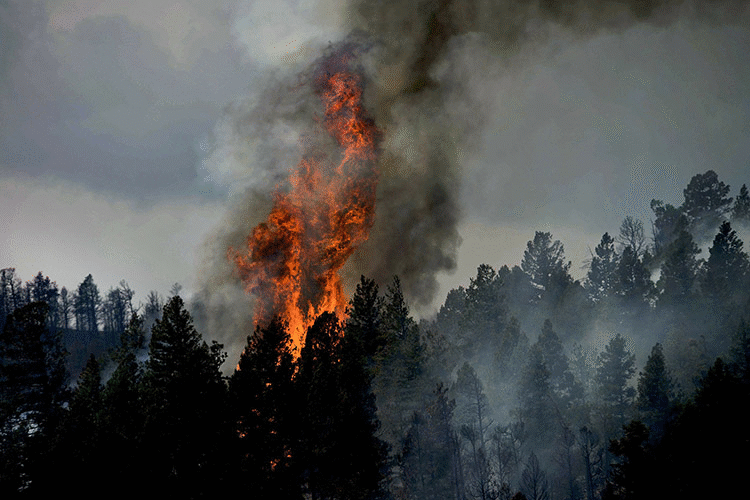Climate Change and Forest Management in Forest Fire Risk in Fennoscandia

27 August 2023
Jaakko Schroderus, Assistant fire chief at Kainuu Rescue Department
This report discusses the impact of climate change on forest fire management in Fennoscandia, with accelerated warming leading to increased fire risks and larger-scale fires. Effective fire prevention policies, forest management practices, and reductions in black carbon emissions are crucial for mitigating the consequences of climate change on forest fires. Proposed solutions include cooperation, enhanced tracking, and community education to improve forest fire management in the region.
Climate change
Fennoscandia, the northern European peninsula which includes the Scandinavian and Kola peninsula, Finland, and Karelia is projected to warm faster than the global average. The warming will lead to decreased soil moisture and increased fire risk. Consequently, severe fire-prone weather conditions are expected to occur more frequently across the region. Current projections estimate an increase of global mean temperatures by 1-4°C during the 21st century. However, the rate of warming depends on greenhouse gas emissions. The most recent report by the Intergovernmental Panel on Climate Change evaluated four different trajectories of greenhouse gas concentrations. Even the lowest trajectory, with a 1°C increase, is projected to surpass the 2015 Paris Agreement's target to limit global warming below 2°C compared to the pre-industrial level of the 19th century.
These temperature increases carry multiple concerns around forest fire management. Throughout the entire circumboreal region, encompassing most of Canada, Alaska, Northern Russia, and Fennoscandia, a reduction in soil moisture and a rise in temperatures are anticipated. This will lead to elevated fire risks, including an upsurge in fires covering areas larger than 10 hectares. Additionally, the severity of fire-prone weather is expected to strain current fire management capabilities, potentially resulting in a significant increase in large-scale fires.
Fires across Finland, Sweden, and Karelia
When looking at historical trends, statistics show that in Finland and Sweden the burnt area has significantly decreased since the 19th century. In the Republic of Karelia, the area burnt was largest during the 1960s and 1970s. At the same time, the number of wildfire occurrences across Fennoscandia remains at the same levels. The reduction in burnt areas is contributed to effective fire prevention policies: improved fire observation, fire suppressions, and forest management.
In Finland, burnt areas have significantly decreased. Data collection begun in 1865 by the Finnish Forest Service. During the 19th century and until the 1930s, the annual area burnt was 10 000-15 000 hectares. The decline in burnt areas was steep from the 1960s and dropped to the average of under 1000 hectares where it remains to this day. The consistent decline and low fluctuation of burnt areas is attributed to the forest management practices enacted after WW2. Massive clearcutting caused increased radiation on open areas and sapling stands, which reduced the moss carpets on the surface and an interruption of flammable areas. Policies in the 1950s and 1960s pine sowing and planting, which self-prune causing a vertical fuel discontinuity. This leads to a reduced crown fire risk and low-intensity surface fires, which are easier to control and extinguish. In addition, commercial thinning of forests reduced crown density and fuel load. High numbers of roads developed for timber truck also support fire prevention by acting as fuel breaks. In addition, firefighting vehicles gain better accessibility, reducing the times to reach fires.
Black carbon
Black carbon occurs through the incomplete combustion of substances that contain carbon, such as fossil fuels, coal, diesel, and wood. It has negative effects on health and contributes to climate warming as it absorbs solar radiation thus decreasing the reflectivity of snow and ice. The number of forest fires is projected to increase which will lead to larger black carbon emissions. Globally, the largest contributors to black carbon emissions are open biomass burnings (36%), residential cooking, heating, and illumination (25%), transport (19%) and industry (19%). Across continents, the shares of annual emissions are Asia 39%, Africa 24%, Latin America 14%, Europe 6%, Easter Europe, Caucasus and Central Asia 6%, North America 5%, Pacific 4%, and the Middle East 2%. Black carbon and CO2 are considered as the greatest contributors to climate warming. CO2 is a gaseous compound that can linger in the atmosphere for thousands of years, preventing heat radiation from escaping from earth into space. Black carbon remains in the atmosphere for a few weeks and can travel great distances across the globe before falling to the surface through rain or snow. With its heat capturing properties, black carbon has the ability to heat up the atmosphere. As it remains in the atmosphere for only a few weeks, emission reductions could have a quick effect on slowing global warming.
The Finnish context of forest fire management
Forest fires in Finland represent only a small portion of emergency operations conducted annually. In 2016, the portion of forest fires and wildfires was 2,8% out of 103 756 emergency operations conducted, and in 2020 it was 3,9% out of 101 973 emergency operations. Fires operations are however labor intensive and require large amounts of personnel and equipment. The seasonal fire readiness can put pressure on standby readiness and puts pressure on the staff’s ability to cope with work.
Finland has 22 regional rescue departments covering the whole country. The departments are organized around professional fire brigades and supported by contract firefighters and volunteers in remote or rural areas. The ministry of the interior enacts the National Rescue Act, which directs the rescue services, provides oversight and a level of quality on a national level. Each regional rescue department conducts risk assessment and produces a ‘’service standard decision’’, outlining the threats and objectives of the operations.
The paragraph discusses the challenges and proposed solutions to enhance forest fire management. The objective is to improve all aspects of civil security, covering prevention, preparedness, mitigation, and extinguishing efforts. The five points are as follows: 1) Cooperation, needed to share material resources, workforce, and expertise. This includes domestic and EU cooperation among rescue services, as well as cooperation between the rescue services and the forestry sector; 2) Enhanced tracking, to improve the speed and precision of fire detection and modelling of how the fire might spread to prepare firefighting strategies; 3) Agile response equipment, for challenging forest fires extinguishing operations and better coordination in the field; 4) Community education, since most fires are caused by human actions. More channels for communication with the public on risks and threats, and educational campaigns through schools, nature tourism hotspots and related nature tourism entrepreneurs, and 5) Attention to sparsely populated areas, by maintaining contract fire brigades and shifting extinguishing work to aerial firefighting due to reduce road maintenance.
The Kainuu Rescue Services participate as end users and pilot hosts on forest fires in the TEMA project. Various data will be collected around forest fires to support the development of observations, modelling and predictions of forest fires. At the moment, the Kainuu Rescue Services participate in the definition of end user requirements and technical requirements for their work and the technologies involved. In conclusion, Finland has had a consistently small burnt area for many decades. However, climate change will cause more extreme and damaging fires in the future. Therefore, means to prepare, act, and react are becoming part of the rescue services’ agenda to reduce the impacts and costs they cause.
Bibliography
Aalto, J. and Venäläinen, A. (eds.), Climate change and forest management affect forest fire risk in Fennoscandia. (pp. 17-27). Finnish Meteorological Institute Reports 2021: 3.

